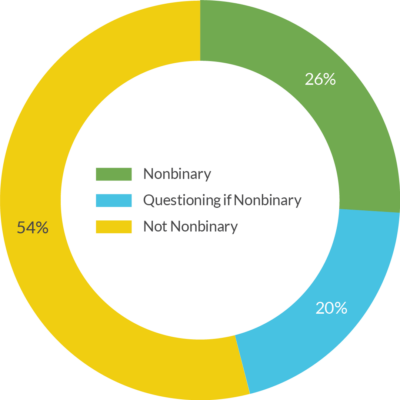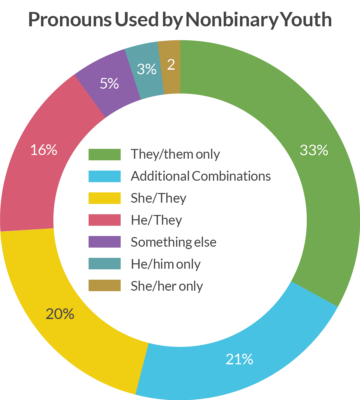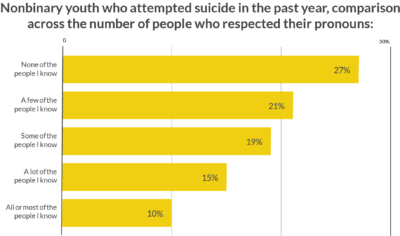Youth's Lives Every Day
Summary
“Nonbinary” is a term used to describe people whose gender identity does not fit within the traditional construction of gender as a binary choice between exclusively male or exclusively female. Although transgender and nonbinary identities can overlap, they are not synonyms that can be used interchangeably. Like the term transgender, nonbinary can be a distinct gender identity, or it can be an umbrella term that refers to other identities outside of the gender binary, such as genderfluid, genderqueer, or agender. While nonbinary people have existed and expressed their genders throughout human history, public awareness of nonbinary people has grown exponentially in recent years. A recent poll found that 35% of Generation Z (those ages 13 to 21 in 2018) know someone who uses gender-neutral pronouns (Parker et al., 2019). Twenty states and the District of Columbia now allow citizens to express a nonbinary identity on their driver’s license, and 14 states allow citizens to indicate a nonbinary identity on their birth certificate (Movement Advancement Project, 2021). The U.S. State Department also recently announced policy changes to make it easier for transgender and nonbinary people to change the gender marker on their U.S. passport, in preparation for offering a third gender option in the future (Jakes, 2021). In celebration of International Nonbinary People’s Day on July 14th, this brief uses data from The Trevor Project’s 2021 National Survey on LGBTQ Youth Mental Health to examine the diversity of nonbinary youth.
Results
One in four LGBTQ youth (26%) in our sample identified as nonbinary. An additional 20% reported that they are not sure or are questioning if they are nonbinary. While nonbinary identities have often been grouped under the umbrella term of “transgender,” our data show that only 50% of youth who identified as nonbinary also identified as transgender; an additional 20% were not sure or questioning if they were transgender.
Within the nonbinary umbrella, most youth used the term “nonbinary” to describe their gender identity (72%). Other commonly used gender identity labels within the nonbinary umbrella included queer (29%), gender non-conforming (27%), genderfluid (24%), genderqueer (23%), androgynous (23%), agender (15%), demigirl (10%), demiboy (8%), genderflux (4%), and bigender (4%). Broken down by the sex assigned by medical professionals at birth, 17% of survey respondents who were assigned male at birth identified as nonbinary and 28% of respondents who were assigned female at birth identified as nonbinary. Most nonbinary youth reported being multisexual or attracted to multiple genders. Among nonbinary youth in our sample, 28% were bisexual, 27% were pansexual, 22% were queer, 14% were lesbian, 6% were gay, 2% were questioning their sexual orientation, and less than 1% described their sexual orientation as straight. Youth between the ages of 13–17 (26%) identified as nonbinary at comparable rates to those ages 18–24 (27%). Rates of identifying as nonbinary were also relatively comparable across races/ethnicities, including 30% of multiracial youth, 27% of Native/Indigenous youth, 25% of Asian American/Pacific Islander youth, 25% of Black youth, 25% of white youth, and 23% of Latinx youth.

The majority of nonbinary youth reported using pronouns outside of the gender binary, such as “they/them” or neopronouns such as “xe/xem.” Neopronouns refer to coined pronouns like ze/zem or e/eem (Hekanaho, 2020). Thirty-three percent of nonbinary respondents reported exclusively using “they,” with only 3% exclusively using “he/him” and 2% exclusively using “she/her.” Many nonbinary youth report using “they/them” pronouns in combination with binary gender pronouns such as “she/her” (20%) or “he/him” (16%). Further, 21% reported using another combination of pronouns such as “she/he/they”, or “they/them” and neopronouns. Finally, 5% of nonbinary youth reported exclusively using pronouns other than “he,” “she,” or “they,” with the most common neopronouns being, “xe/xem.”

When asked about ways other people can make them feel happy or euphoric about their gender, nonbinary youth overwhelmingly responded: having people in their life use the correct name and pronouns to refer to them. One youth noted, “It makes me extremely happy when people respect and use my correct pronouns, and I could literally happy cry.” Other responses mentioned feeling affirmed when people used gender-neutral compliments, or compliments not associated with the gender that youth were assigned at birth. One respondent described their friends calling them “thude” or “a mix of they and dude” as something that makes them feel good about their gender. Affirming relationships with parents, siblings, friends, and partners were also a frequently cited source of affirmation and happiness for nonbinary youth.
Nonbinary youth who reported that “no one” respected their pronouns had more than 2.5x the rate of attempting suicide compared to those who reported that “all or most of the people” they know respected their pronouns. Among those who didn’t have anyone in their life who respected their pronouns, 27% attempted suicide in the past year. The rate of attempting suicide in the past year dropped to 15% when a lot of people respected their pronouns and 10% when all or most people respected their pronouns.

Methodology
Data were collected from an online survey conducted between October and December of 2020 of 34,759 LGBTQ youth between the ages of 13–24 across the United States recruited via targeted ads on social media. To assess nonbinary identity, youth were asked, “Some people describe themselves as nonbinary when the way they think or feel about their gender is beyond exclusively male or exclusively female. This can include but is not limited to, identifying as having no gender, having a gender somewhere between male and female, having a mix of male and female, or identifying outside of male and female gender identities. Do you identify as nonbinary?” Race/ethnicity, sexual orientation, gender identity labels, and pronoun frequency data were calculated using a subsample of 8,998 nonbinary respondents. Inductive qualitative coding was used to determine themes in 5,330 text responses to the open-ended question: “What are things that others do that make you feel happy (or euphoric) about your gender?” To assess other’s use of their pronouns, youth who indicated they were transgender or nonbinary were asked, “How many people in your life respect your pronouns?” with response options that included, 1) None of the people I know, 2) A few of the people I know, 3) Some of the people I know, 4) A lot of the people I know, and 5) All or most of the people I know. Our item on attempted suicide (“During the past 12 months, how many times did you actually attempt suicide?”) was taken from the CDC’s Youth Risk Behavior Survey.
Looking Ahead
While much progress toward LGBTQ equality has been achieved in recent decades, there is still much work to be done for the full inclusion of transgender and nonbinary youth. These results confirm that while transgender and nonbinary identities are related, youth understand them as distinct identities, with more than one in four LGBTQ youth identifying as nonbinary. Nonbinary youth use a variety of language to describe their gender, and most use pronouns outside of the gender binary. Nonbinary youth emphatically report that respecting their pronouns is the best way to help them feel supported and affirmed in their gender, and our data show that respecting a nonbinary young person’s pronouns decreases their risk of attempting suicide. This data supports policies that encourage respect for nonbinary youth’s pronouns in settings where youth most often interact, such as schools, medical facilities, and social service organizations. Further, there is a need for training of teachers, coaches, and all adults who work with youth about how to include and affirm nonbinary young people. Understanding and respecting the pronouns of nonbinary youth can be life-saving.
As part of The Trevor Project’s mission to end suicide among all LGBTQ youth, we recognize the need to include and respect nonbinary youth in all sectors of society. Our public education team offers training for organizations seeking to provide more inclusive programming, our research team works to provide data on ways to best support nonbinary youth, and our advocacy team fights for inclusive policies that affirm nonbinary identities. Our Crisis Services programs and TrevorSpace are available 24/7 to ensure that all nonbinary youth have a place where they can find support and be affirmed in their identity. Although there are many evidence-informed approaches that can be taken to reduce suicide risk, affirming and respecting the pronouns of nonbinary youth is a simple practice that anyone can do to improve the well-being of nonbinary youth.
Recommended Citation: The Trevor Project. (2021). Diversity of Nonbinary Youth. https://doi.org/10.70226/ZORR6401
| ReferencesHekanaho, L. (2020). Generic and Nonbinary Pronouns: Usage, Acceptability and Attitudes. [Doctoral dissertation, University of Helsinki.] Jakes, L. (2021, June 30). The State Dept. will no longer require medical documents proving gender for U.S. passport applicants. The New York Times. https://www.nytimes.com/2021/06/30/us/politics/gender-passports.html. Movement Advancement Project. (2021). Equality Maps: Identity Document Laws and Policies. Available at: https://www.lgbtmap.org/equality-maps/identity_document_laws Accessed on June 30, 2021.Parker, K., Graf, N., & Igielnik, R. (2019). Generation Z Looks a Lot Like Millennials on Key Social and Political Issues. Pew Research Center’s Social & Demographic Trends Project. Available at:https://www.pewresearch.org/social-trends/2019/01/17/generation-z-looks-a-lot-like-millennials-on-key-social-and-political-issues/ Accessed on June 17, 2021. |
For more information please contact: [email protected]
© The Trevor Project 2021